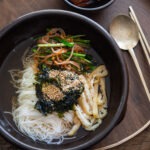
Janchi Guksu (Korean Banquet Noodle Soup)
Easy janchi guksu with anchovy broth, somyeon noodles, mung bean sprouts, chives, and fried tofu—a light, comforting noodle soup for any occasion.
Ingredients
- 8 oz (225 g) somyeon noodles
Broth (see note):
- 5 cups (1.2 liters) water
- 1 bag anchovy-kelp dashi packet or 3 anchovy stock coins
- 1 tbsp (15 ml) Korean fish sauce
- pinches salt to taste
Vegetable topping
- 7 oz (200 g) mung bean sprouts
- 1 1/2 oz (40 g) Asian chives sliced
- 1 1/2 tbsp (22 ml) soy sauce
- 1 tbsp (15 ml) Korean fish sauce
- 1 tbsp (15 ml) Korean chili flakes (gochugaru)
- 1 tsp (5 g) sugar
Optional toppings
- 3-4 fried tofu (yubu) sliced
- 1 bag roasted seaweed snacks crumbled
- 2 tbsp (6 g) toasted seaweed crushed
- fried egg strips
- chopped kimchi
Instructions
- Make the broth: In a pot, combine 5 cups of water with a anchovy stock packet. Bring to a boil, then reduce heat and simmer for 10 minutes. Remove the packet. Season the broth with Korean fish sauce and salt to taste. Keep warm.
- Cook the noodles Boil somyeon (thin Korean wheat noodles) in a large pot of water according to the package instructions. Add a splash of cold water once or twice during cooking to help the noodles stay chewy. When done, drain and rinse under cold running water to stop the cooking and remove excess starch. Set aside.
- Prepare the mung bean sprout topping: Bring a small pot of water to a boil. Blanch mung bean sprouts for 5 seconds, then immediately rinse in cold water. Drain well. In a bowl, toss with chopped Asian chives, soy sauce, Korean fish sauce, Korean chili flakes (gochugaru), sugar, and a sprinkle of sesame seeds.
- Prepare additional toppings: Cut fried tofu (yubu) into strips or bite-sized pieces. You can also prep thin egg strips (jidan), kimchi, or other toppings if desired. Set aside crumbled roasted seaweed and toasted sesame seeds for garnish.
- Assemble and serve: Divide the cooked noodles into serving bowls. Arrange the mung bean sprout mixture and tofu on top. Add seaweed and sesame seeds. Gently ladle the hot broth around the noodles, just enough to immerse them. Serve immediately.
Video
Notes
- For the most authentic flavor, use dried Korean anchovies (with heads and guts removed) to make the broth. They add deep umami without overpowering the soup.
- If you're not a fan of anchovy stock, you can substitute with beef broth or chicken broth for a richer, heartier flavor.
- For a vegetarian option, use a light vegetable broth made with dried shiitake mushrooms and kelp (dashima). Keep in mind that each broth will bring its own unique taste to the dish.
Nutrition
Calories: 588kcal | Carbohydrates: 113g | Protein: 31g | Fat: 4g | Saturated Fat: 0.2g | Polyunsaturated Fat: 0.4g | Monounsaturated Fat: 0.2g | Sodium: 3630mg | Potassium: 369mg | Fiber: 12g | Sugar: 21g | Vitamin A: 2135IU | Vitamin C: 32mg | Calcium: 141mg | Iron: 4mg